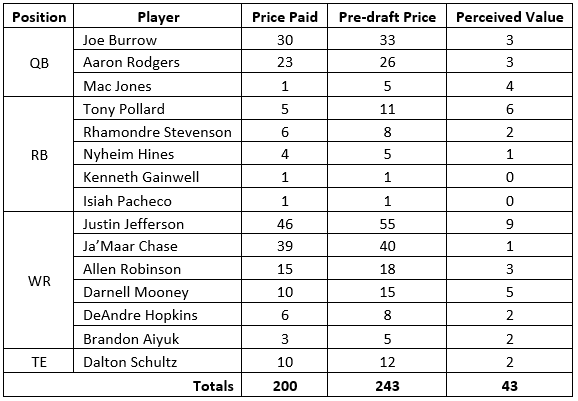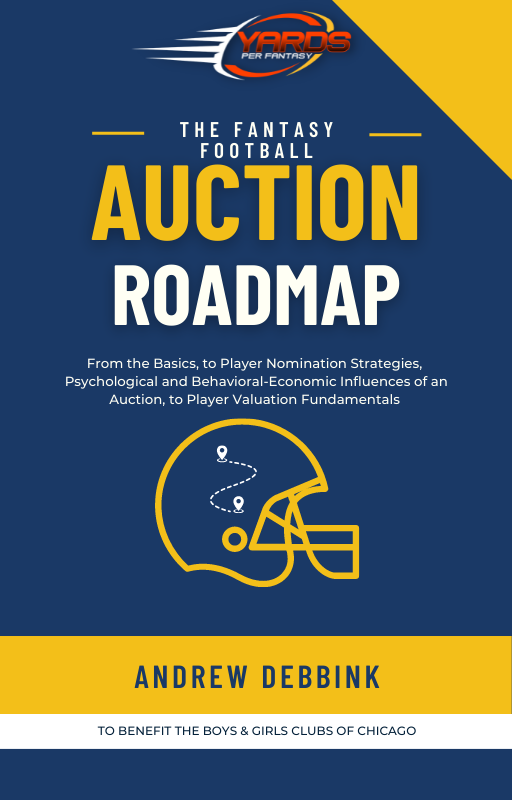 Draft With Us On Underdog! Use Promo-Code: YARDSPER for a 100% deposit match up to $100!
Draft With Us On Underdog! Use Promo-Code: YARDSPER for a 100% deposit match up to $100!
Case Study: Value Based Auction Draft Strategy
Fantasy football auction drafts have grown in popularity in recent years due to the increased flexibility the format provides in constructing your roster. The possibilities of how to construct your roster are nearly endless, which is what is both exciting and scary about the format. Newcomers to auctions often worry, ‘Can I ruin my season before it has even begun?’ In short, the answer is yes, but perhaps not in the ways you might think.
Generally, when people evaluate an auction drafter’s results, they have a tendency to focus on the weakest spots of the roster rather than thinking about the bigger picture. They over-emphasize roster ‘balance’ across all positions. But in reality, it doesn’t matter at what positions you spend your dollars, only whether the dollars you spend provide you with more realized points than the dollars your league mates spend.
As I’ve realized and accepted this truth more and more over the years, I’ve become a huge proponent of a “Value-Based Drafting” approach in auction drafts. Under a Value-Based Drafting approach in an auction draft, a manager does not go into the auction with a budgeted amount he/she expects to spend for any position groups or roster spots. They do not shoot for any particular “roster construction.” They largely disregard the notion of a ‘balanced’ roster. Instead, the manager uses essentially no budget, and only approaches the auction with their assessed player values in hand. The manager tries to find the best deals possible relative to their player values to maximize the value they walk away with from the auction. The only real ‘budgeting’ or distinction that matters is how much they spend on their ‘starters’ versus how much they spend on their ‘bench.’
I applied a true value-based draft strategy in my most competitive auction league this year, and believe my team was championship caliber. While my team was not seen as ‘balanced’ coming out of the draft, I finished first place in the regular season with the most points scored (I’ll let you know how the playoffs finished up at the end of this article). The purpose of this article is to provide a ‘case study’ of a true value-based drafting team, and illustrate why it is such a powerful strategy in auction drafts, for those who still question its merits.
League Format and My Results
The league is a 12-team, $200 budget, superflex, no kicker, no defense, 6 bench spots, 0.5 PPR. Starting lineups include:
- 2 QBs (assuming all use a QB in their superflex)
- 2 RBs
- 2 WRs
- 1 TE
- 2 flex
I use a “value over replacement player” analysis based on player point projections to initially set my individual player values, and then qualitative adjustments based on perceived risks/upside. It’s worth noting off the top that this league’s auction results ended up mirroring my pre-draft player prices better than any mock I did in the offseason.
While values were accordingly hard to come by, I was able to walk away with a team that was worth $243 based on my price sheet. Here was my team out of the draft, how much I paid in the auction, how much I valued the player at prior to the auction, and therefore the perceived ‘value’ I got on that player on draft day:
Results Observations
- I was happy with a total team value of $243 based on how closely prices mirrored my price sheet. I found a couple ‘bigger’ values in Jefferson and Pollard; otherwise, I nickel and dimed my way to solid value all around. It was encouraging to see I could still walk away with $243 of value, even in a difficult room. In other, less experienced rooms, you often can walk away with even more value.
- It’s important to note that, while I was looking for value in the draft, that does NOT mean that I did not spend up on stud players. I still got 4 of my top 40 priced players, including one tied for the highest priced player on my board (who I viewed to be my best value in the whole draft). A common misconception of value-based auction strategies is that you don’t get true stud players. This is not true. The only question is whether the price is right. You just need to find where the value presents itself.
- Going into the draft, my plan was to spend $189 on my ‘starters’ and $11 on my bench players. I ultimately spent $184 on starters and $16 on my bench. While less starter heavy than I intended, I was closely tracking this split to ensure I didn’t end up overly bench heavy in my spending. I’ll write more this offseason on ways to track this mid-draft. But in this case, RB spending was inflated across almost all tiers of the position, which is what pushed me towards slightly more bench spending (to take advantage of lower WR prices, and not overpay on my ‘starting’ RBs) than I anticipated.
- Accordingly, I ended up with a “Zero-RB” type build. This wasn’t my plan going in, but rather where I perceived the value to be based on my pre-draft prices. As noted in the introduction, people tend to assess auction rosters based on the perceived weakness(es) of the team, rather than thinking of overall production and value. This was certainly feedback I received on my roster after my draft. The prevailing comment was on how ugly my RB situation looked on paper, despite the great players I accumulated everywhere else.
- A list (and a few quick notes) on players that went right:
- Burrow: ended up trading, but returned his price and then some
- Pollard/Stevenson: liked both going into the draft, and baked upside into their pre-draft prices. But didn’t envision how much each would outperform their billing. Undoubtedly fortunate in this “Zero-RB” build, but even if they just lived up to a ‘most likely projection,’ their prices would be great.
- Jefferson: Early hesitancy to spend too much on high end receivers, and infatuation with building out RB depth, gave me my co-WR1 at a far-too-friendly price.
- Chase: My most interesting player. Already had Burrow when Chase was nominated. Had I not already had Burrow, would not have paid $39 for Chase and I would have looked elsewhere for bigger deals. But Chase still took another step to superstardom while on the field and lived up to his billing.
- Hopkins: Nominated late in the auction. I had already secured Jefferson, Chase, Robinson, Mooney, and Aiyuk. I had a $6 max bid, and the best players left on the board were Hopkins and Devonta Smith. Given WR depth already, Hopkins’ upside out of his suspension was a perfect fit, and gave team a mid-season boost.
- Aiyuk: ended up trading, but ended up a rock solid WR2 all year for $3.
- A list (and a few quick notes) on players that were misses:
- Rodgers: ended up trading, but didn’t quite live up to his billing. Still surprisingly consistent QB2 in hindsight.
- Robinson: ended up trading after week 2, but like others, I was just too high on a player that busted.
- Mooney: Another pure miss like Robinson. Didn’t appreciate the low passing volume, and expected a higher target share for him.
- Schultz: Came around in 2nd half, but early-season nagging knee injury forced me to drop him given a relatively short bench.
Benefit #1 of Value-Based Drafting: Greater Margin for Error
In every year in fantasy football, you have to assume you will have misses. It is part of the game. There are players every year that disappoint for some reason or another. But getting as much value as possible gives you much greater room for error in your auction draft.
For example, suppose I got $0 value from Robinson, Mooney, and Schultz and only $15 of value from Rodgers. In that case, I would have wasted $43 on those misses ($15 on Robinson, $10 on Mooney, $10 on Schultz, $8 [23-15] on Rodgers). Which means even with these misses, I still walked away with at least $200 in value ($243 minus the $43 wasted on misses). That’s still par for the course, even before factoring in anything that went “right” with players outperforming expectation. By hunting for value, I essentially ensured I could light $43 on fire and still compete with everyone else.
Benefit #2 of Value-Based Drafting: Trade Market Ammunition
By stockpiling as much value as possible, you also give yourself the most flexibility to make trades with your league mates. I was able to make several trades that played a key role in shaping my team into a championship contender. A few of the key ones:
Trade 1:

- I made this trade after week 2, when Schultz appeared to have a long-term injury issue, and Rodgers and Robinson were coming off of solid games, but not games that fully put me at ease after their shoddy week 1 performances. The team I traded with needed depth, and I was able to shift uncertain pieces and depth for two pieces that I was more confident in.
Trade 2:

- I made this trade after week 4. Pollard and Stevenson hadn’t yet showed what they would be all year, and I was keen for more RB depth. I was optimistic on the Eagles’ offense giving Sanders many scoring opportunities going forward, and getting Geno and Jameis (along with Mac Jones on my bench) seemed like a platoon I could work with to fill Burrow’s void. The move bolstered my depth and gave me everything I needed for upcoming bye weeks. It also allowed me to pull off my next trade…
Trade 3:

- I made this trade after week 7. My team had really solid depth and made it through many byes already, so I was looking for that last superstar that would put me over the top. CMC was that guy, and he proceeded to be one of the best (if not the best) RBs over the back half of the year.
These trades illustrate how stock piling value in the draft allows you to make moves when you get into the season. Not only can you absorb your potential misses, but you can have value leftover to navigate the trade waters and fill any perceived holes on your team. Or you can take two players and package them for a player you are more confident in/a stud.
It’s worth noting, though, that you should consider how active your league’s trade market tends to be before heading into your auction. In this league, I know there is generally high activity, so I was confident I could flip value into a needed position/player if it was required. If you have less confidence that your league will be active, there may be a case to be slightly less value-based in your approach, and ensure you have some safe options at all positions out of the draft. But overall, you should still look for the best values possible at each position.
Summary
So why recap my season for you? Am I that vain that I think everyone cares about my fantasy team and how it did?
Certainly not. But I thought an example of what I believed was a well-executed, value-based auction draft could help some visualize what it might look like, how it might play out during the year, and answer common questions/misconceptions about the strategy. Perhaps seeing this case study gives you the confidence to try out a true value-based draft approach in your auction league in 2023.
In short, the key takeaways are:
- Value-based auction drafting does NOT mean you do not take stud players. It just means you take players at prices lower than your pre-draft assigned values.
- More important than your breakdown of spend between positions is your breakdown of spend between starters and bench players.
- Value-based drafting can help you absorb your ‘misses,’ giving you far more room for error than if you pursue certain players at a premium cost.
- Value-based drafting will give you the most flexibility possible in-season to make trades and react to the ever-evolving player value market.
I will be putting out more articles on value-based auction strategies, tips, and tricks this offseason. Stay tuned and give me a follow on Twitter if you’re interested in learning more ahead of next year!
Appendix: My Results
You didn’t think I was going to leave you hanging on the results here, did you? Maybe you don’t care, but in case you’re wondering…
My team finished first place in the regular season and had the most points scored during the regular season. I credit this primarily to my numbers-driven, value-based approach to assigning auction values to players this offseason, and following the value in the draft.
Heading into the playoffs, my starting lineup was:
- QB: Kirk Cousins
- Superflex: Geno Smith
- RB1: Christian McCaffrey
- RB2: Tony Pollard
- WR1: Justin Jefferson
- WR2: Ja’Marr Chase
- TE1: George Kittle
- Flex1: DeAndre Hopkins
- Flex2: Christian Watson
I felt as confident as could be, but as we all know, fantasy football playoffs have a mind of their own. After the bye week, I lost in the semi-finals to a team that I believe I would have beaten 8 games out of 10. I got relatively down weeks from CMC, Chase, Pollard, and Geno. Christian Watson didn’t play the second half due to injury. And Hopkins caught 1 of 10 targets from Trace McSorley. A down week still saw me put up 131, which would have beat any other team in the playoffs that week, but it wasn’t enough to overcome my opponent’s 136.
Then, I lost in the 3rd place game after a trainwreck day from my Vikings (Cousins 7.9, Jefferson 2.0, Thielen [in place of Watson] 2.1). Even with Hopkins and Pollard missing that week, I filled valiantly with Allgeier (16) and Hollywood (9.1). The Vikings dud was just too much to overcome.
A disappointing end to what should have been a promising year. But with the process I’ve developed, I have little doubt I’ll be back with another shot at a title next year.









